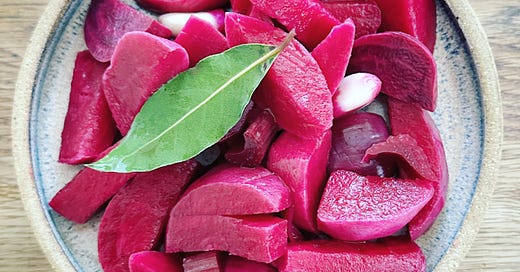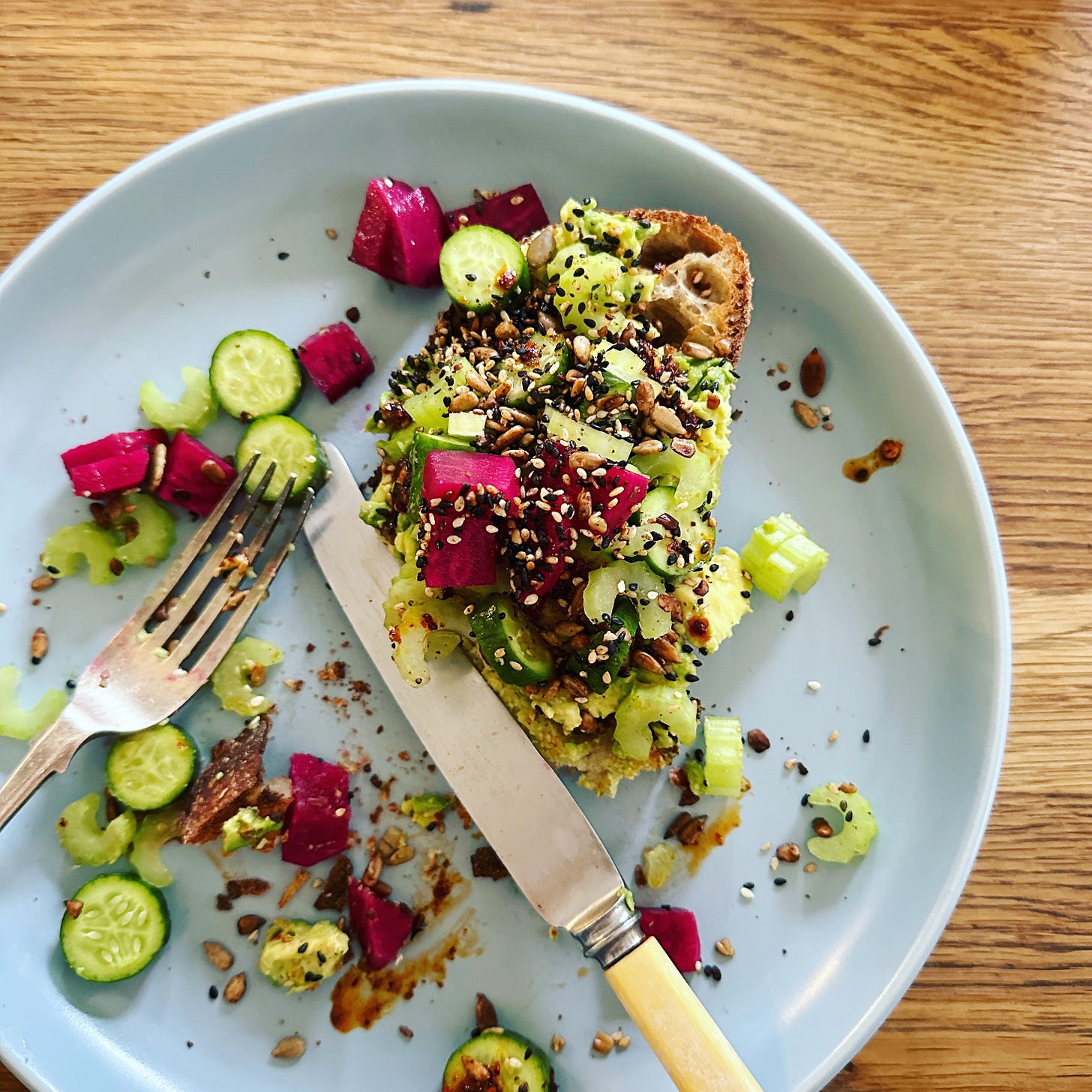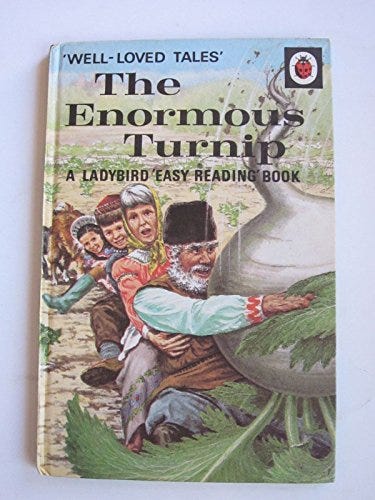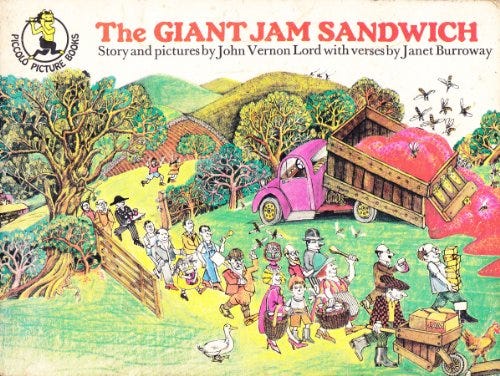In Good Taste #1: Pink Pickled Turnips
Torshi Left AKA falafel's best friend; giant foodstuffs in children's books; the terror of AI
Well, hello there! How are you?
Good I hope. Thank you so much for being here.
I’m just recovering from a bout of Covid but more or less back to my normal self. I had to cancel a few classes which was a shame - apologies if you’d been planning on coming to see me at either Borough Kitchen or the Dusty Knuckle - but the full “groo” phase lasted less than a week, an improvement on the fortnight of fatigue I had this time last year.
So. Welcome to the first edition proper of In Good Taste.
As the weeks go by we’ll be talking about the science of lacto-fermentation, going over basic principles and investigating everything from what salt to use to the best equipment, cooking with ferments, uses for leftover brine and lots more besides. But I didn’t want you to get all bogged down in theory or feel you needed a microbiology degree before pickling anything. So let’s kick off with a recipe and circle back to the rest.
We’re going in with torshi left AKA pink pickled turnips. These are one my my favourite things to make as they’re both delicious and striking looking. Made with cheap, seasonal root veg, you get a lot of bang for your buck. Plus saying “pink pickled turnips” is very pleasing in a tongue-twistery kind of way.
If you’ve come across these before, it’s likely to be as an accompaniment to falafel. And they are indeed perfect jammed into a fluffy pitta along with crispy-squishy fried chickpea balls, hummus, salad and all the rest. But you can chuck them in anywhere where you want a bit of colour and crunch and acidity. Here are a few chopped up in a salad with cucumber and celery, enlivening the avocado on toast I ate for my lunch yesterday. Which would otherwise have been unforgivably and shamefully basic and I never would have shown it to you. But look! I just can’t get enough of that pink and green colour scheme…
The word torshi originates from the Persian for “sour” and you can find it used for pickles all across the Middle East and Balkan area. Including Hebew (also torshi), Kurdish (tirşîn), Turkish (turşu), Albanian (turshi) and Grek (τουρσί). Left just means turnip.
Poor old turnips. They’re a bit undervalued these days. Perhaps I feel fondly towards them because of this book we had when I was little:
Although, if I’m honest, it was less exciting to me than the other book on our shelves about outsize foodstuffs:
But I digress. Torshi left are best made using normal sized turnips. The colour is perfectly natural and comes from adding a beetroot. Depending on how much you use it can dye the turnips to an eye-popping fluorescent pink or a deeper purple, almost indistinguishable from the beets themselves.
Shall we make some? Your sandwiches, salads and falafel will thank you.
Recipe: Torshi Left
You’ll need a large jar or fermenting crock. These quantities make roughly a 750ml/1l jar but feel free to scale up or down.
Ingredients
6 Turnips
1 Beetroot
3 garlic cloves
1 celery stick (plus leaves if possible)
4 bay leaves (fresh or dried, either is fine)
25g sea salt
100ml cider or white wine vinegar
Method
Peel the turnips and beetroot and cut them into thick batons. I like mine about a 1cm square but you do you. Also chop the celery stick into manageable lengths.
Put the garlic, celery and two bay leaves at the bottom of your jar and then fill it up with the turnip and beetroot. Pack them down well.
Mix the salt into 500ml water until it is fully dissolved then add the vinegar. Pour this brine into the jar, making sure all the vegetables are covered.
Add the final two bay leaves and something to weigh the vegetables down. This could be a glass or ceramic pickle weight if you have one. But you don’t need specialist equipment. You could use a smaller jar that fits inside the mouth or the first, a cabbage leaf or other large veg scrap or a plastic sandwich bag filled with water (or, better yet any leftover brine in case it leaks). You just need something that keeps the veg pieces under the brine as they ferment.
Seal the jar and put it somewhere at room temperature, out of direct sunlight. I recommend putting a plate underneath in case it leaks when things get going.
Leave for between one and two weeks, “burping” the jar every couple of days to let out any gas (careful when you do this as the bright pink brine can stain your clothes). The brine will become deeper in colour over the first few days and the turnips will turn from white to pink. Taste them regularly. When they have reached a level of acidity you like, move them to the fridge. They’ll keep for several months.
Notes
The celery is optional but recommended, I just really like the extra flavour it brings. The garlic not only brings flavour but extra microbial action so is a great addition.
Whatever you do, don’t skip the bay leaves. They contain tannins which are really important for keeping your pickles crunchy.
There you go! Not the absolute simplest ferment ever (hello sauerkraut - we’ll be coming back for you!) but easy as anything. Any questions comment below or drop me a line. In a few weeks time I’ll tell you something fabulous you can cook with the beautiful purple brine so don’t throw it away if you eat all your turnips before then. In the meantime, enjoy your pickles in salads and wraps or just straight from the jar.
Cultural Fun
I see Ben Moor is doing a coupe of his more recent shows at the Hen & Chickens. I’ve known Ben for a long time and seen every show he’s done since 2005 and his work is always unique. He creates strange worlds and odd stories. Who Here’s Lost (18th and 19th April) is a monologue about an architectural road trip. BookTalkBookTalkBook (23rd May), a two-hander with Jo Neary is a very amusing and surreal parody of live author events. I would recommend either/both if you like slightly weird comedy with a melancholy edge.
Happy to learn the Max Fisher has joined the Crooked Media podcastiverse. His book The Chaos Machine: The Inside Story of How Social Media Rewired Our Minds and Our World was super interesting (and also very worrying). I don’t listen to Pod Save America as much as I used to. It’s depressing staying too well-informed about things you can’t do anything about. But Offline is consistently interesting and has a more hopeful feel to it. Or at least I always feel hopeful when I hear smart people talking about possible solutions to problems. Fisher was a great interviewee when he was on last year so I’m excited to hear more of him.
In further Technology Is Terrifying News, this episode of Ezra Klein’s podcast was a good introduction into the current state of AI and where it might go, post GPT-4. From mass redundancy in the creative industries to the ability to talk to dead people, it’s big stuff.
At my most pessimistic I think about AI as Jeff Goldblum’s character in Jurassic Park thought about genetically cloning dinosaurs: “Your scientists were so preoccupied with if they could, they didn’t stop to consider if they should!” A small but significant proportion of people working on it think it might wipe out humanity! And even if it doesn’t, I agree with Nick Cave about GPT’s much-vaunted creative ability. Currently at least it’s no more than “a kind of burlesque”. I wonder how long before it starts cooking…
Bye! See you next week!
In the meantime, if you felt like sharing In Good Taste with friends or family who might enjoy it, you can do so with the button below. It would mean the world to me. Thanks so much.
In Good Taste is a Sycamore Smyth newsletter by me, Clare Heal.
You can also find me on Instagram or visit my website to find information about my catering work, cookery lessons and upcoming events.









